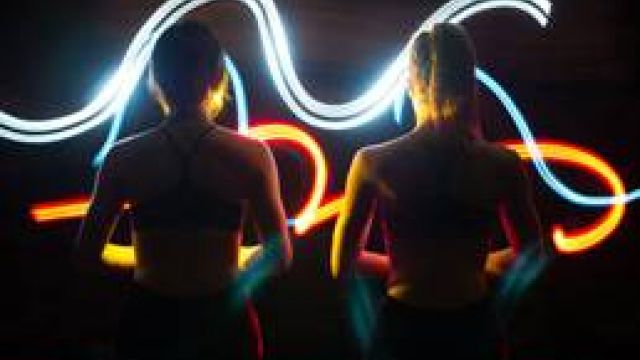Luminous Flux
Wikipedia defines luminous flux as the “perceived power of light adjusted to reflect the various sensitivity of the human eye to detect different wave lengths of light” – a fitting title for this production from the feisty Tasdance ensemble. It is contemporary, abstract, physically exacting , visually compelling – and very exciting.
Featuring the celebrated choreography of Byron Perry (Associate Director of Sydney’s physical theatre company Force Majeure), and the late, and much lamented, Tanja Liedtke, the production explores the physical interpretation of light – reflection, refraction, shades of visibility, half light, lack of light.
Enter Twilightis a reproduction of the exacting and very precise choreography created by Liedtke that “explores the paradox that exists between life’s rituals”.
To an eerie, sometimes discordant sound track by DJ Tr!p, on an stage where two L-shaped rostra face each other on diagonal corners, the performers, Sarah Fiddaman, Brianna Kell, Jenni Large and Timothy Walsh, use a complexity of tightly controlled staccatic movement – or stay completely still – as they explore the effect of twilight. They tie themselves into one knot, then emerge into another. Spasmic, wind-up doll-like movements blend into intricate up-beat rhythmic interpretations of relationships and emotions.
Moving together, in tiny steps they appear to glide across the stage. Sitting together on the rostra, they appear to glide around the surface, then sit, perfectly still – or disappear. Seldom is any segment extended, just as the phases of dawn or twilight are seen momentarily, and pass swiftly into light – or dark.
This is a fine tribute to Liedtke and her aim to blend dance and theatre.
Byron Perry’s exploration of the physical nature of light is excitingly abstract – and at times effectively amusing. Eight fluorescent light tubes, lying at right angles, border the stage. The performers, joined by Dean Cross, are dressed in white skivvies and shorts. Lit from all angles, they sit, stark and still, as a voice over intones, repetitively, “White light, White light”. Eventually there is a slight movement. It is repeated, and stopped. Another follows. Then heads begin to move as one, slowly at first, then faster. A sound emerges from one of the performers. Another is added and repeated, becoming faster and louder. Small movements are added. The sound becomes panting breaths, laughter, moans …
And so the scene is set for this sometimes playful, intricately structured, visually hypnotic dance work. Perry not only plays with interpreting light, he plays with it physically. Leading to the finale, four of the dancers move the fluorescent tubes into smaller and smaller rectangles of light, as the remaining dancer moves inside. Eventually the lights are moved into a single line. Then they go out – and are replaced by torches held by the dancers. Then ensues a cleverly contrived piece of choreography that is visually exciting. The torches flash on and off as the dancers weave and swirl to punctuated sound, that changes rhythm constantly until it slows to nothing – and darkness.
This is a beautifully constructed and visually enchanting example of dynamic contemporary dance theatre. It is a credit to the creative vision of Artistic Director Annie Greig, the ingenious choreography of Liedtke and Perry and physical precision, vitality and personalities of the Tasdance performers … but only two performances in Sydney!
Carol Wimmer
Subscribe to our E-Newsletter, buy our latest print edition or find a Performing Arts book at Book Nook.

